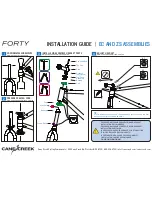
Remote Control Commands
R&S
®
NRPxxT(N)
63
User Manual 1177.6023.02 ─ 08
Numeric suffixes <n>
If a command can be applied to multiple instances of an object, e.g. specific sensors,
the required instances can be specified by a suffix added to the command. Numeric
suffixes are indicated by angular brackets (<1...4>, <n>, <I>) and are replaced by a
single value in the command. Entries without a suffix are interpreted as having the suf-
fix 1.
Optional keywords [ ]
Some command systems permit certain keywords to be inserted into the header or
omitted. These keywords are marked by square brackets in the description. The instru-
ment must recognize the long command to comply with the SCPI standard. Some com-
mands are considerably shortened by these optional mnemonics.
Therefore, not only is there a short and a long form for the commands (distinguished
here by uppercase and lowercase letters) but also a short form which is created by
omitting optional keywords.
Example:
Command
[SENSe<Sensor>:][POWer:][AVG:]SMOothing:STATe 1
can be writ-
ten as:
SENSe1:POWer:AVG:SMOothing:STATe 1
SENS:POW:AVG:SMO:STAT 1
SENSe:POWer:SMOothing:STATe 1
SENSe:SMOothing:STATe 1
SMOothing:STATe 1
SMO:STAT 1
Parameters
Parameters must be separated from the header by a "white space". If several parame-
ters are specified in a command, they are separated by a comma (,). For a description
of the parameter types, refer to
Chapter 11.2.3, "SCPI Parameters"
Example:
Definition:
[SENSe<Sensor>:]AVERage:COUNt:AUTO:NSRatio <nsr>
Command:
AVER:COUN:AUTO:NSR 0.01
Notations
















































